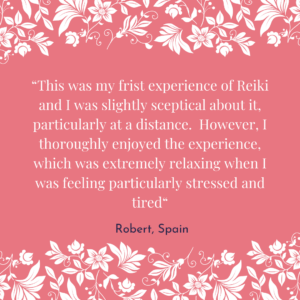 What is it?
What is it?
Reiki (pronounced ray-key) is a Japanese word meaning “Universal Life Force Energy”, an energy which is all around us. Reiki is based on the premise that illness is caused by a disruption in the body’s energy field or life force. By using specially designed symbols and channelling energy, it is believed that the body can be filled with positive energy causing the disease-making negative energy to disappear.
Alison has been practising Reiki since 1999 and became a Reiki Master Practitioner in 2001.
How does it work?
Reiki heals by charging negatively affected parts of the energy field with positive energy. Energy fields in the body each have different vibratory levels and reiki practitioners use their hands to affect and hopefully rebalance these vibrations in the negatively affected part of the body.
What does it involve?
The treatment last approximately 60 minutes including the pre and post consultation. The session starts with a short video consultation where the reiki practitioner may ask questions about your health prior to treatment, it is important to note that no diagnosis, prognosis or advice will be offered and ask how you would like to follow up after treatment. Remaining fully clothed, the client will prepare for treatment by relaxing on a bed or sitting if that is more comfortable.
For Distance Reiki, the practitioner will mirror the hand positions used at an in-person session gently over the body in a sequence of positions, each one being held for a couple of minutes. Although personal experiences differ, some people report feeling an intense heat from the practitioner’s hands during the process. The client does not have to think about or do anything, as it is the practitioner’s aim to provide a gentle, warming, vital energy appropriate for the recipient.
What is it good for?
Reiki can be used to relieve the symptoms of chronic illnesses such as anxiety, insomnia, back pain and arthritis, and it often produces long-term beneficial changes. In most cases the practitioner will suggest a course of four, six or twelve treatments for maximum benefit. Aside from treating physical, mental and emotional problems, most clients report that a reiki treatment feels wonderful, and promotes a sense of relaxation and well being.
What are the side effects and when should it be avoided?
As a general rule, reiki can’t do any harm because it is a form of non-invasive energy healing and will adjust itself to create the most appropriate effect for each individual person. However, although most people feel peaceful and relaxed after treatment, it can stir up emotions as part of the healing process. Some people also experience a healing reaction such as a headache or flulike symptoms, but any discomfort should be short-lived. Clients often report feelings of relaxation and calmness after a treatment. It is best to avoid alcohol and coffee following Reiki.
What do I do next?
Any questions, call us on 01313341311 or Schedule appointment or Buy Gift Voucher.

 What is it?
What is it?